On Caravaggio’s Trail: Travelling to Research A NAME IN BLOOD
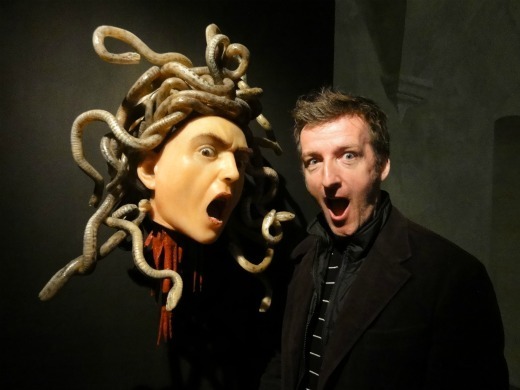
As I researched A Name in Blood, my novel of Caravaggio, I went all over Europe and North America, tracking Caravaggio's works and the places that touched his life. The period locations I visited gave me a flavour for Caravaggio’s life. In some cases, they gave me ideas for plot twists in the book.
Everywhere I found people fascinated with this most compelling of artists. On one of my sojourns in Rome, there was an exhibition devoted to Caravaggio's use of mirrors to project images (over which he painted, giving the vivid realistic feel people usually notice when they first see his work). He used his own head, probably in a convex mirror, to paint his "Medusa," which ended up in Florence at the Galleria Uffizi. The Rome exhibit made a nice mock up. Life size, as you see, though perhaps not as scary as a traveling author making a funny face.
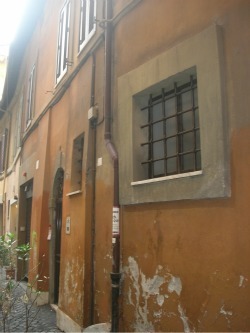
Caravaggio lived most of his time in Rome in the palaces of wealthy patrons. For a brief period, he rented this house (right) in a tiny street in Rome's historic center. Then he fell behind on the rent, lost the place, got drunk and went around to break his landlady's windows. I stood in the tiny alley imagining what it must have been like to be Madama Bruni, with a raging nutcase hurling rocks at her shutters from a yard away and bellowing that he was going to carve her up. Unfortunately I had to cut that incident out of A Name in Blood because, as with some other juicy moments in Caravaggio’s life, they were deeply revealing, but they didn’t drive my narrative forward.
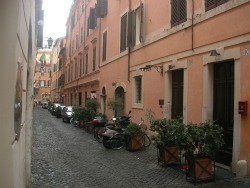
Caravaggio’s model (and, I think, lover) Lena lived here (left). In the Via dei Greci. In the heart of what used to be the Ortaccio, or Evil Garden, where only whores and the very poor lived. And artists, of course. Both places are now very expensive spots in the middle of Rome’s tourist area. But they're still redolent of C's time. At night, they're dark and empty. Though not spooky. I never get spooked in Rome. I’m too damned happy there.
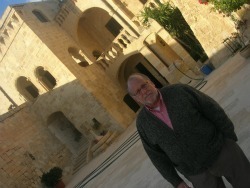
Rome was an important stop on my researches into period locations (as opposed to my more farflung journeys to the many galleries housing Caravaggio’s work), but Malta was in many ways the most compelling, because Caravaggio’s influence is still so considerable. Caravaggio is an important figure for its capital, Valletta, where he became a Knight of Malta and painted one of his masterpieces, The Beheading of Saint John for the city’s cathedral. Father John Critien (right) is the only Knight of Malta who currently lives in Castle Sant'Angelo on Valletta's harbor. C was imprisoned here, and made a dramatic escape. Father John and I spent a delightful afternoon examining all the spots where Caravaggio might've been held. Many think it was in a hole in the rock called the guva.
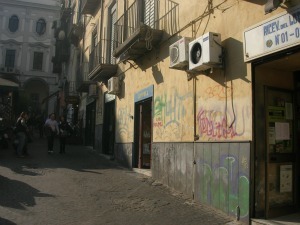
On to Naples I went. At left is the site of the Ceriglio Tavern, where Caravaggio was attacked on his way out. He got a scar, probably just to teach him a lesson rather than an attempt to kill him, and an injury to his eye, which can be seen in his last work, David with the Head of Goliath. I noticed that for much of the afternoon anyone leaving the Ceriglio and headed toward Caravaggio's digs at what’s now called the Palazzo Cellamare would be blinded by the sunlight. A good time for an attack.
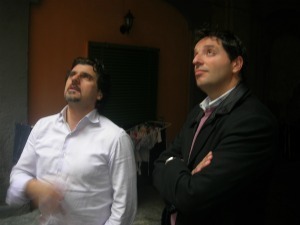
My friend Ugo Somma, far right, showed me around Naples. Here he is examining the chapel of the Knights with a fellow named Rosario who works for the Knights of Malta in Naples. At first Rosario wouldn't let us look around the Knights' church. But when I told him he looked like Caravaggio, he relented and even introduced me to his sister...
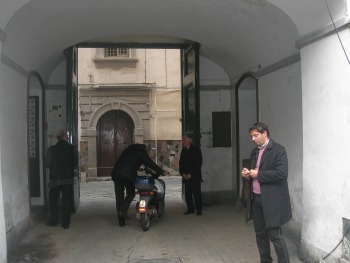
At the Knights' Priory in Naples, these fellows were hanging around in the courtyard looking like mafia capos waiting to rub someone out. A non-Neapolitan had been named that morning as the new Prior. They were, as the Italians say, "arrabiati." Mad as hell. Their sullen expressions and taciturn demeanor gave me an idea for a plot twist in A Name in Blood….
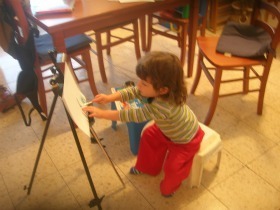
My son became an aficionado of Caravaggio as the research went on. He visited many of the galleries and churches in Rome where Caravaggio’s paintings hang. When I was painting my own versions of Caravaggio’s Madonnas, I told him the woman was named Mary. He decided we had to call his new sister by that name, which we did (in the Welsh fashion, it’s spelled Mari.) His name being Cai, we dubbed him Cairavaggio.
One of my earliest memories is of a schoolteacher who had been in Naples with the British army in World War II. He wasn’t talkative, but one day he told me about a hunchback who had beckoned him to a garden and shown him the most beautiful sight he had ever seen: the perfect view over the Bay of Naples. Somehow that simple recollection of beauty by an old man, unfolded in an uncomplicated way to a small boy, brings tears to my eyes. I found the same beauty in Naples—alongside considerable depravity, too. They say, "See Naples and die." Unfortunately for Caravaggio, that's how it worked out, quite literally. Naples is magical, lively, putrid and beautiful. From the Spanish Palace looking at San Francesco, here's one moment when I thought: Matt, you lucky fellow, isn't "research" great?
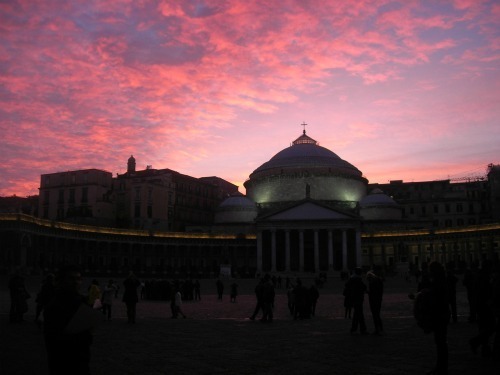
Published on June 06, 2012 04:10
•
Tags:
a-name-in-blood, art, art-history, caravaggio, crime-fiction, historical-fiction, malta, naples, rome
No comments have been added yet.



